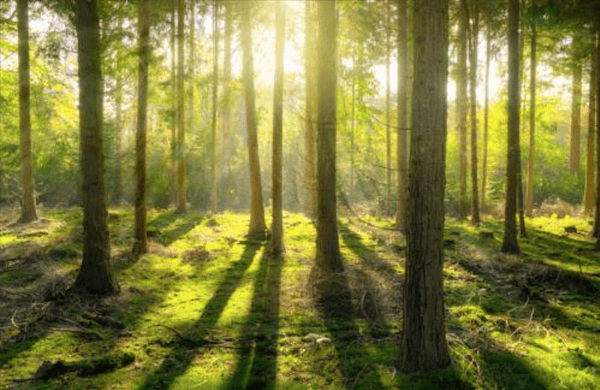Global Environmental Changes Leading to Shorter, Younger Trees
Conditions that Started Decades Ago Are Altering Forests and Will Likely Continue, Global Study Finds
Ongoing environmental changes are transforming forests worldwide, resulting in shorter and younger trees with broad impacts on ecosystems, finds a global team of researchers, including several from the University of Maryland (UMD) Department of Geographical Sciences.
Published in the May 29 issue of Science magazine, research led by the U.S. Department of Energy’s Pacific Northwest National Laboratory found that rising temperatures and carbon dioxide have been altering the world’s forests through increased stress and carbon dioxide fertilization and by causing more frequent and severe natural disturbances such as wildfire, drought and wind damage. Combined with forest harvest, the Earth has witnessed a dramatic decrease in the age and stature of forests. For example, the study reports that due to land-use change total global forest area has declined approximately 12% since 1900, while the area of old growth forests has declined approximately 34%, or nearly three times as fast.
“This trend is likely to continue with climate warming,” said Nate McDowell, a PNNL Earth scientist and the study’s lead author. “A future planet with fewer large, old forests will be very different than what we have grown accustomed to. Older forests often host much higher biodiversity and store more carbon than young forests.”
In the study, “Pervasive shifts in forest dynamics in a changing world,” researchers used satellite imagery along with computer modeling and a detailed literature review to conclude that the globally averaged tree size has declined over the last century and the trend is likely to continue due to environmental changes. UMD Professor George Hurtt, Assistant Research Professor Louise Chini and Adjunct Associate Professor Ben Poulter provided the global land-use data used in the analyses. The UMD researchers study the dynamics of forest ecosystems as part of the NASA Carbon Monitoring System and the NASA Interdisciplinary Science Program.
“Global patterns of land-use activities combined with rising natural disturbance events have reduced both the extent and structure of forests,” Hurtt said. “This has major implications for carbon storage and biodiversity, which are both keys to mitigating climate change. It also makes it more complicated to predict future forest dynamics as environmental conditions continue to change.”
Contributing factors
Both human activity and natural causes—clear-cutting, wildfire, insects and disease—are leading to the loss of trees. Known as deforestation, the phenomenon has led to an imbalance of three important characteristics of a diverse and thriving forest: (1) recruitment, which is the addition of new seedlings to a community; (2) growth, the net increase in biomass or carbon; and (3) mortality, the death of forest trees.
These conditions promoting deforestation will likely accelerate, drastically altering the living conditions for plants and animals, researchers found.
Wide-ranging impact
The study also reveals that other mechanisms of deforestation -- “chronically changing drivers” -- are underway. They include:
- Atmospheric carbon dioxide: Carbon dioxide levels in the atmosphere have increased dramatically since the Industrial Revolution and are projected to continue rising over the next century. Higher levels of carbon dioxide can increase a tree’s growth rate and seed production. However, such carbon dioxide fertilization appears to only happen in younger forests with abundant nutrients and water. Most forests globally are exposed to limitations in nutrients and water, which drastically reduces the carbon dioxide benefits to trees.
- Temperature: Rising temperatures limit life-giving photosynthesis, leading to lower growth, higher mortality, and reduced regeneration. This is one key to shorter trees, the study determined.
- Droughts: They’re expected to increase in frequency, duration and severity globally. Drought can directly cause tree death or indirectly lead to mortality through associated increases in insect or pathogen attack.
Other factors are altering the face of the world’s forests:
- Wildfire is increasing in many forests worldwide and future fires may be more frequent than they have been in the past 10,000 years in some regions, the study found. Plant growth following forest fires may be slow or absent due to elevated temperatures.
- Biotic deforestation disturbances—by insects, fungi and choking vines—have been on the increase.
- Wood harvests have had a huge impact on the shift to younger forests or non-forest land.
More than 20 scientists collaborated to produce the deforestation study, which included data and observations made in more than 160 previous studies.
“Environmental changes are making disturbances worse, and this is causing a change in vegetation dynamics toward shorter, younger forests,” McDowell said.
Originally posted on the BSOS homepage.
Published on Fri, 05/29/2020 - 10:18


